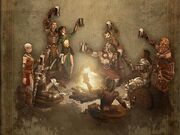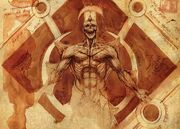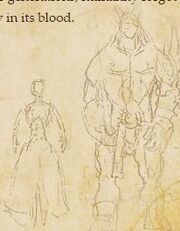
Humans of various ethnicities
Humans, often referred to as humanity, mankind, or simply man, are a mortal race native to Sanctuary. The descendants of the nephalem, humanity has long been the focal point of the ongoing war between Heaven and Hell.
Physiology

Human anatomy
Humans are mortal and upon death, their souls enter a location beyond the reach of angels or demons (though various religions claim otherwise).[1] Half angel and half demon,[2] the two components of a human's soul are integral to their existence.[3] Humans possess the ability to choose between good and evil, an ability that causes many angels to fear mankind.[4]
Humans and demons are capable of interbreeding, usually to the horror of the former. Few children of such couplings survive childbirth, and fewer still survive into adulthood, as they are generally killed by those who know them for what they are.[5] Demons can possess humans, and to best knowledge, the possession cannot be ended without killing the host.[6] Humans are also capable of breeding with nephalem.[1] As with angels and demons, human blood carries Essence.[7]
Human eyesight is inferior to that of angels in most respects, though the human eye is quite adept in picking up light.[8]
History

A human (left) compared to a nephalem (right) in size
The world of Sanctuary was created by rogue angels and demons led by the archangel Inarius and the demoness Lilith, seeking refuge from the Great Conflict. The two races interbred, leading to the birth of the nephalem. Their powers exceeded those of their parents, raising concern that the nephalem might not only become a threat, but could draw the attention of Heaven or Hell to their world. The issue led to bloodshed, as Lilith slaughtered angel and demon alike, fearing for her children's safety. Inarius succeeded in banishing Lilith to the Void, but he was the only one of his kind left on Sanctuary. Alone, he altered the Worldstone to diminish the powers of the nephalem. Each subsequent generation's powers were diminished, to the extent that they became mortal. Eventually, humanity as a whole rose up, unaware of its history bar myths and legends inspired by its nephalem forefathers.[1] Specifically, humanity first emerged in the Temple of the Firstborn,[9] which was constructed in honor of the first nephalem to be born.[10]
Thus, humanity spread across Sanctuary. Building cities, collecting knowledge, and developing distinct cultures and ethnicities. This was a period of relative peace, but it was not to last, as the lords of Hell eventually discovered the mortal realm. This discovery led to the Sin War, a covert battle between Hell and Inarius to turn humanity to their own ends. It ended with an agreement between Heaven and Hell that humanity would be allowed to choose its own path between Light and Dark. After the pact was sealed, humanity's memories of the terrible events were wiped clean and was given a second chance to start over.

The plight of mankind
Such has been the state of Man since this time. The Prime Evils have made plays to turn humanity to Chaos, while the archangel Tyrael and mortal heroes have often foiled them.[1] In recent times, after the destruction of the Worldstone, nephalem have emerged amongst humanity, an event coinciding with the end of the Great Conflict. Thus, Tyrael declared that humans and angels would stand together as one.[11] It was a hollow declaration[12] as humanity found itself nearly eradicated by rogue angels called Reapers. While the Nephalem was able to save humankind,[13] angelkind was mostly indifferent to humanity's suffering.[4] Humanity remained in peril, as death and ruin were reaped upon Sanctuary, the champion of the Light unable to protect those in need.[14]
Cultures and Ethnicities

A human touched by the influence of demons
Numerous different human groups exist across Sanctuary, their traits differing in accordance with their location and culture. Human cultures can broadly fall into one of two viewpoints. The first of these is mysticism—the study of magic, and the root desire for humanity to become the master of its own destiny. The other viewpoint is faith—the view that humanity must put its trust in powers beyond mortal understanding to determine its fate and establish ethical and moral guidelines to live by. The prominence of both viewpoints has waxed and waned over time.[1] Many times, human societies have dedicated themselves to malignant beings.
Isolated human societies often grow and advance at incredible rates.[15]
Examples of human cultures and ethnicities include the following:
Askari
The Askari (often referred to as "Amazons") are native to the Skovos Isles, located south of the Western Kingdoms. Their society is matriarchal and caste-based, while their mythology is polytheistic, mostly centered around the nephalem Philios,[1] but also features worship of many other gods.[16]
Children of Bul-Kathos
The Children of Bul-Kathos exist in two distinct branches—the Barbarians of the Northern Steppes (now the Dreadlands) and the Druids of Scosglen. Central to both cultures was the Worldstone, and both built their societies around their protection of it. With the Worldstone's destruction, the Barbarians lost their homeland and scattered to various parts of the world in exile.[1]
People of Aranoch
A number of nomadic human tribes inhabit Aranoch, though Lut Gholein is a permanent settlement. The land itself acts as a barrier between the East and West of Sanctuary.[1] Many ruins dot the landscape—relics of times long gone.[17]
People of the East
Kehjistan is the dominant power of the East, and perhaps no other region has been as influential in shaping human civilization in Sanctuary. It is in this region that some of the most influential discoveries in religion, philosophy, magic, and science, have been made. The land has a tumultuous history, what with the Mage Clan Wars, the coming of Zakarum, the corruption of Kurast and Travincal,[1] and most recently, the corruption of Caldeum by Belial. The kingdom was left paralyzed by his manipulations of Hakan II, but his yoke was removed, much to the joy of the populace.[18]
The Vecin are present in this region.[18]
The Ascenians inhabit a highlands area of the region.[19]
People of Greyhollow Island
A human civilization developed on Greyhollow Island that developed into a grand empire. For reasons unknown, the society collapsed, leaving chaos in its wake.[15]
People of Ivgorod
The people of Ivgorod are seclusive. Once a mighty civilization, Ivgorod is now confined to its single capital. Ruled by a religious oligarchy, the religion of Ivgorod is Sahptev, which preaches the exist of 1001 gods and goddesses. This system dominates every aspect of the lives of Ivgorod's people.[1]
People of the Torajan Jungles
The Torajan Jungles are located southwest of Kehjistan, and have seen numerous civilizations rise and fall over time. The Umbaru are the only exception to this. The Umbaru clans frequently war with one another in ritualistic warfare, to honor the spirits of the rainforest. Their overriding faith is in the Mbwiru Eikura, a "true reality" beyond the mortal realm.[1]
The Opaya inhabit(ed) the southern region of the jungles.[20]
People of the Western Kingdoms
The West of Sanctuary encompasses the kingdoms of Westmarch, Khanduras, and Entsteig. The kingdoms have their origins in the crusade led by Rakkis in the name of Zakarum, and consequently, Zakarum is the West's dominant religion. That being said, variation exists—Entsteig still practices ancient pagan rituals, melding their folklore with worship of the Light. Westmarch is a healthy, vibrant kingdom, and is currently a forward-looking civilization as Zakarum influence declines. Khanduras is best known for its suffering at the hands of Diablo, though merchants have since returned to the region.[1]
People of the Swamplands
The Swamplands are located in the far east of Sanctuary, beyond Kehjistan.[1] The people of this region are of fairer hair and skin than the Kehjistani.[21]
Xian
Main article: Xian
Xiansai is Sanctuary's northernmost nation, and due to its insular nature, Xian culture developed free from major foreign influence. Xian society is dominated by the Great Families, which each controls a portion of their kingdom's economy. Xian religion is polytheistic, featuring numerous gods, albeit without any distinct hierarchy.[1]
Other
The Custerians are a now-extinct race of humans.[22]
The Samurenians were the people of the Samuren Empire.[23]
The Boosenians were a people who possessed exceptionally talented smiths.[24]
In-game
All playable classes in all three Diablo games are humans. In Diablo III, the protagonist(s) is/are referred to as the Nephalem, though, and turn out to be the actual nephalem rather than mere humans. Most humans encountered in either game are friendly or neutral towards the player characters, offering various services as NPCs.
In Diablo I and II, humans are rarely encountered as enemies: to some extent, Zakarum zealots in Act III are human enemies, and Mages in the first game are presumed to be ones (even though both types are greatly corrupted). There are no special effects that work against humans.
In Diablo III, Brigands, Templar Inquisitors, Westmarch Soldiers, Hired Mages and Dark Cultists / Dark Vessels of the Coven are human enemies. Pig Sticker is the only item in game with bonus against humans. Some unique monsters, such as Jondar and Rad'Noj Necromancers, are also of Human type.
Most, but not all, types of undead in all three games are risen from human corpses.
Trivia
- Compared to Warcraft and StarCraft, the humans of the Diablo series are the most normally proportioned.[25]
References
- ↑ 1.00 1.01 1.02 1.03 1.04 1.05 1.06 1.07 1.08 1.09 1.10 1.11 1.12 1.13 Book of Cain
- ↑ 2013-12-08, BlizzCon 2013 – Diablo III Lore and Story Q&A Panel Transcript. Blizzplanet, accessed on 2014-03-26
- ↑ Diablo III, Act V
- ↑ 4.0 4.1 2014-05-19, More Info From The Anniversary Dev Stream. Diablo Fans.com, accessed on 2014-05-20
- ↑ Moon of the Spider
- ↑ Demonsbane
- ↑ Rise of the Necromancer, Blizzard Entertainment. Accessed on 2017-06-30
- ↑ Storm of Light
- ↑ 2016-11-20, BlizzCon 2016 Diablo III Dev Talk Panel Transcript. Blizzplanet, accessed on 2016-11-20
- ↑ 2016-11-04, Necromancer Blizzcon Diablo 3 Fact Sheet. Diablo.net, accessed on 2016-11-07
- ↑ Diablo III, Act IV Ending Cinematic
- ↑ Book of Tyrael
- ↑ Diablo III, Act V
- ↑ 2016-11-04, Diablo III: Rise of the Necromancer Pack Reveal – BlizzCon 2016. YouTube, accessed on 2016-11-07
- ↑ 15.0 15.1 2015-12-11, PATCH 2.4.0 PREVIEW: GREYHOLLOW ISLAND. Blizzard Entertainment, accessed on 2015-12-16
- ↑ Diablo II Manual
- ↑ Diablo II, The Secret of the Vizjerei
- ↑ 18.0 18.1 Diablo III, Act II
- ↑ Scales of the Serpent
- ↑ Diablo III, Deathseer's Cowl
- ↑ 2014-03-10, THE HISTORY BEHIND THE CRUSADE. Blizzard Entertainment, accessed on 2014-03-07
- ↑ Diablo III, Custerian Wristguards
- ↑ Diablo III, Raekor's Heart
- ↑ Diablo III, Faithful Memory
- ↑ 2014-05-31, Inside Heroes of the Storm, Blizzard's MOBA mash-up of Diablo, StarCraft, and WarCraft. PC World, accessed on 2014-06-03
